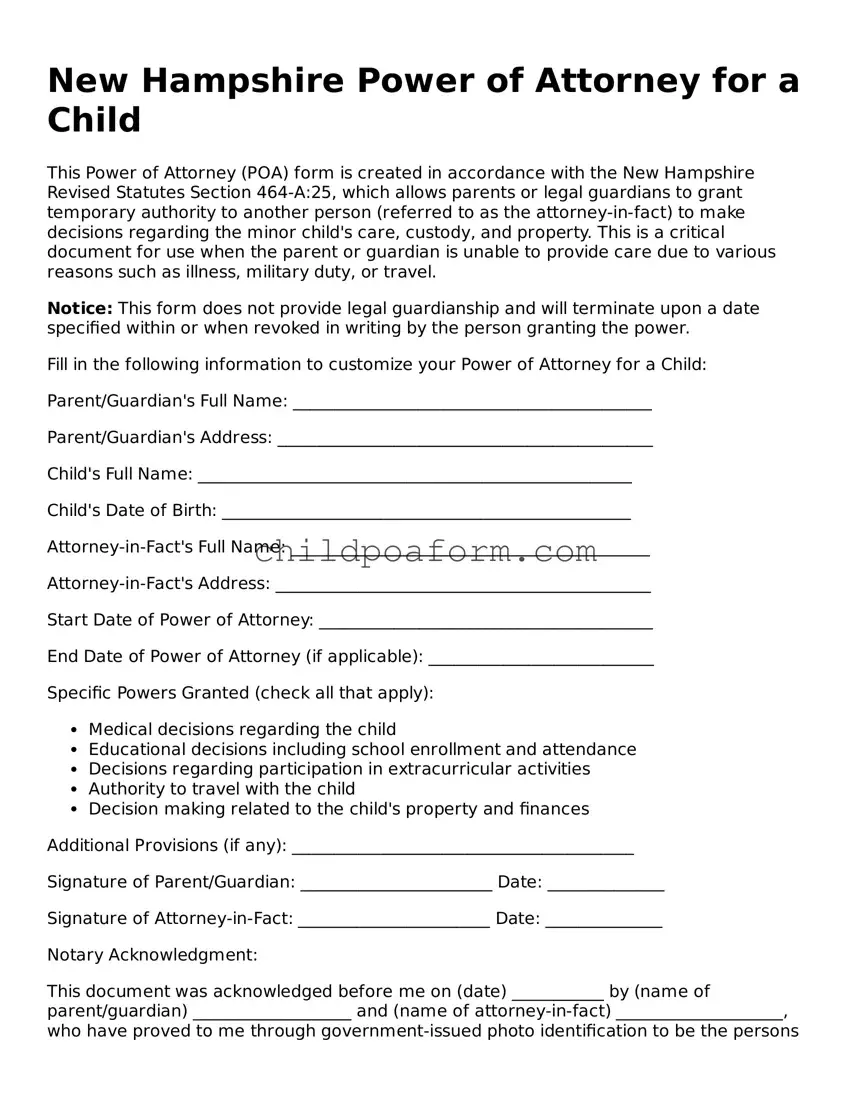Instructions on Utilizing New Hampshire Power of Attorney for a Child
In the context of the New Hampshire Power of Attorney for a child, individuals are granted the capability to appoint another person to make decisions regarding the welfare of a child under certain circumstances. This legal document is instrumental when a parent or guardian anticipates being unavailable due to various reasons, such as illness, military service, or other obligations, and wishes to ensure the child's affairs are managed by a trusted individual. Proper completion and understanding of the form are crucial to ensure it meets legal standards and fully protects the child's interests. The steps outlined below are designed to guide you through filling out the New Hampshire Power of Attorney for a child form efficiently and accurately.
- Gather all necessary information: Collect full legal names and contact details of the person(s) granting power, the individual receiving power, and the child/children involved.
- Read through the form: Before filling anything out, thoroughly read the document to understand all sections and requirements.
- Fill out the parent/guardian section: Input the name(s) and address(es) of the child’s current parent(s) or legal guardian(s).
- Identify the attorney-in-fact: Input the full name and contact information of the person being appointed as the attorney-in-fact, who will make decisions for the child.
- Specify the child's information: Enter the full name, date of birth, and address of the child. If there are multiple children being included under this Power of Attorney, provide information for each one.
- Determine powers granted: Clearly mark or write out the specific powers and responsibilities the parent or guardian is transferring to the attorney-in-fact. This might include decisions regarding education, healthcare, and general welfare.
- Set the duration: Specify the effective date and, if applicable, the termination date of the Power of Attorney. Unless otherwise noted, the document will remain in effect for up to six months, as per New Hampshire law.
- Review limitations and exclusions: Carefully read through any limitations on the attorney-in-fact’s powers or any rights that the parent/guardian retains. Ensure understanding and agreement before proceeding.
- Sign and date the form: The parent or legal guardian must sign and date the form in the presence of a notary public. This step legally authorizes the agreement.
- Notarize the document: Have the document officially notarized by a licensed notary public to ensure its legal validity.
- Provide copies to relevant parties: Distribute copies of the completed and notarized form to the attorney-in-fact and retain a copy for personal records. It may also be necessary to provide copies to the child’s school, healthcare providers, and any other institutions requiring verification of the attorney-in-fact’s authority.
By following these steps, individuals can confidently execute a Power of Attorney for a child form that is compliant with New Hampshire laws and fulfills their intent to secure the welfare of the child in their absence. It is important to consult with legal counsel or a professional knowledgeable in New Hampshire law if there are any uncertainties or complex situations that need expert guidance.
